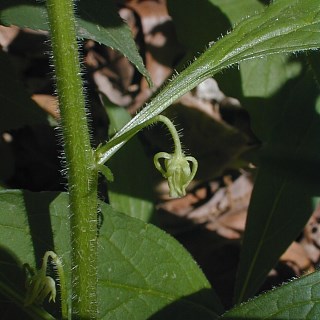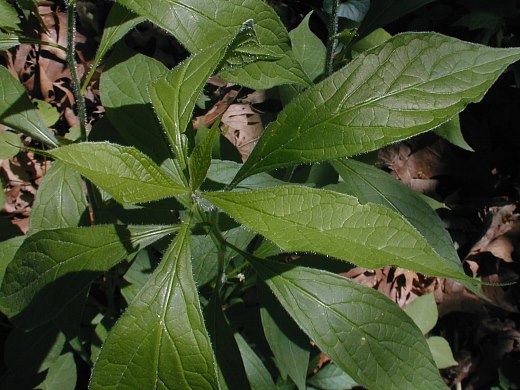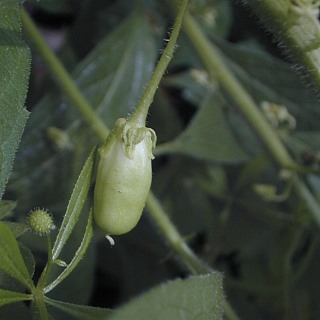Description: This perennial wildflower is 1½–3' tall and usually unbranched. The central stem is hairy. The alternate leaves are up to 6" long and 1½" across; they are medium to dark green and elliptic in shape. The leaf margins are smooth and ciliate; on rare occasions, a few teeth may occur along the outer margins. Each leaf tapers gradually to a wedge-shaped base and a short petiole. The upper and lower surfaces of each leaf are hairless to somewhat hairy. At the upper axil of each leaf, there are 1-3 small nodding flowers that are light green. Each flower is about ¼" long, consisting of 5 linear sepals, 5 oblong petals, 5 stamens, and a pistil. The pedicel of each flower is about ½" long and hairy. Near the base of each pedicel, there is a pair of linear stipules (leafy bracts) up to ¼" long. Terminal flowers are not produced.

The blooming
period occurs from mid-spring to early summer
and lasts about 1–1½ months. There is no noticeable floral scent. Each
fertile flower is replaced by a seed capsule about ½–¾" long. The seed
capsules are light green, ovoid-oblongoid in shape, and hairless. At
maturity, each capsule splits into 3 sections to release the seeds. The
root system is is fibrous and rhizomatous. Clonal colonies of
plants are occasionally formed from the rhizomes.
Cultivation:
The preference is dappled sunlight to medium shade, moist to mesic
conditions, and a rich loamy soil with abundant organic matter (e.g.,
fallen leaves). Some rocky material (e.g., limestone) is also
tolerated. The pH of the soil should be mildly acid, neutral, or basic.

Range &
Habitat:
The native Green Violet is occasional in most areas of Illinois, except
in the NW
section, where it is absent (see Distribution
Map). Overall, it is more common in hilly areas of southern
Illinois than in the glaciated areas of northern Illinois. Habitats
include moist to mesic deciduous woodlands, wooded slopes, shaded
terraces along streams, and damp ravines, particularly where calcareous
rocky material is close to the surface of the ground. This species is
fairly conservative and normally found in high quality woodlands where
the original ground flora is still intact.
Faunal Associations:
Very little is known about floral-faunal relationships for this
species. Robertson observed a green metallic bee, Augochlorella
striata, sucking nectar from the flowers; however, insect
visitors to the non-showy flowers are uncommon. The polyphagous insect,
Acrosternum hilaris (Green Stink Bug; a.k.a. Chinavia
hilare) sucks juices from the foliage. White-Tailed Deer
often chomp off the tops of this plant. It is possible that upland
gamebirds and the White-Footed Mouse feed on the seeds, which are
rather large in size.

Photographic
Location:
A shaded ravine in Vermilion County, Illinois.
Comments:
This atypical member of the Violet family is primarily a foliage plant;
the small flowers are largely hidden by the leaves and non-showy. The
seed capsules of Green Violet are very similar in appearance to those
of other violets (Viola spp.), although they are
somewhat larger in size; the seed capsules of both the Green Violet and
other violets divide into 3 longitudinal sections to release their
seeds. There is also some similarity in the structure of their
respective flowers. Looking at this plant, most people would never
guess that it is a violet.